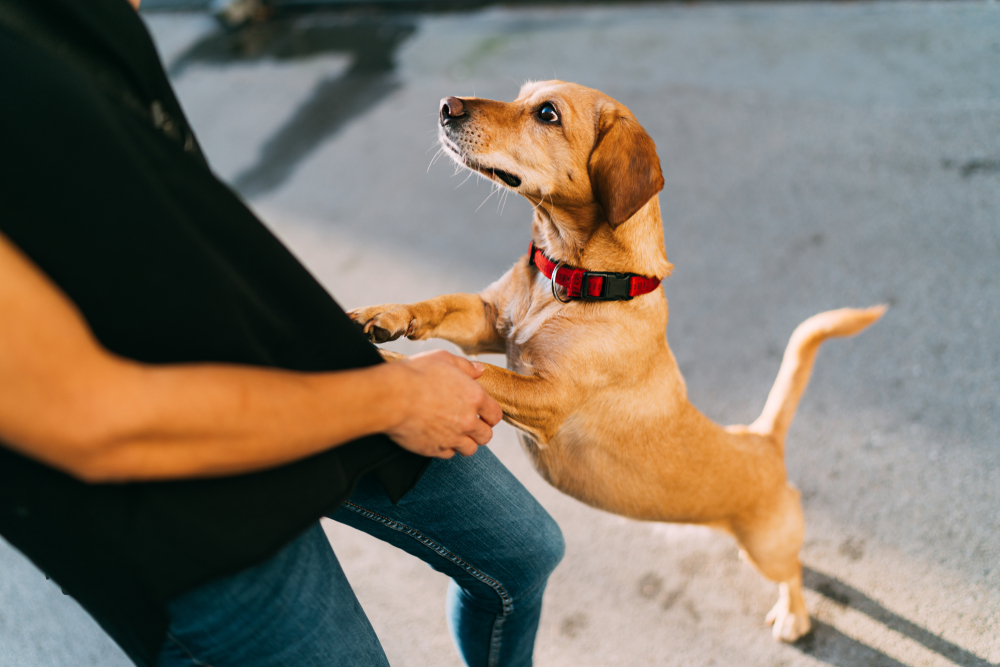No matter if you’ve spent a couple of hours or a whole doggy lifetime with your furry friend, you already know that the answer to “Is my dog trying to tell me something?” is yes! But, what exactly do their huffs, woofs, and roos mean? Is there a universal doggy language that we can learn to better understand our canine companions?
As it turns out, there are a few common vocalisations that dogs rely on to communicate with their humans. You’ve probably heard some of them at 5am, others you might have heard when your doggo spotted the pet treats delivery courier! And now, you’ll know exactly what your pupper is saying in every situation.

Is my dog trying to tell me something urgent?
It’s the middle of the night and your dog starts barking at top lung capacity, waking the whole neighbourhood in the process. Why are they doing it? Here are a few vocalisations associated with your dog’s inner alarm system:
- Warning barks. Warning barks are the first indication that your dog has noticed something amiss. A warning bark may consist of a group of three or four barks with a pause in between to allow them to listen for more information. And it will generally subside when the potential threat has passed. It basically means, “Hey human, just letting you know that I’ve detected something! Might be nothing! I’ll keep you posted!”
- Emergency barks. Whether your dog takes on the role of dedicated protector or they’re usually on the more passive side, most dogs will bark if they detect imminent danger. This could be brought on by a stranger or animal very close to the house or a sudden unexpected noise. Typically if a dog is in this defensive state, their barking will be low pitched and continuous.
- Whining. If your dog is in the middle of an episode of anxiety, they may share their distress in the form of whining. A pup in full freak-out mode will whine with sharp yips or howls interspersed to show they really do not like what is happening and that they need help. This could be brought on by separation anxiety, fireworks, or even a health emergency of someone in their vicinity.
Overall, the message of these vocalisations is, “Hey, something is wrong and needs attention!”
Is my dog trying to tell me something sweet?
Doggos don’t just share when they’re feeling threatened, they also talk to us when they have happy thoughts on their mind! Here are a few vocalisations that will melt your heart:
- Happy grunts, roos, brrs, and woofs. If your doggo grunts and huffs when you walk into a room, chances are, they’re letting you know it’s nice to see you. Dogs are even capable of a form of purring, or rattling woof, that is a sure sign they’re in a good mood. You can be sure that those grunts are happy if they’re paired with excited eye contact and a tail wag.
- Sleepy moans and sighs. If your doggo just woke up from the best nap of their lives, you might get to hear their adorably content groans and moans. These vocalisations mean, “I’m so relaxed. Please keep scratching my belly. Wouldn’t it be nice to sleep on the sofa all afternoon?”
- Good mood barking. When your dog is excited about something, their barking will be high pitched and grouped into small bursts. Whether they’re playing with other dogs or their favourite human, this type of barking usually means, “Boy, this is great. Come on over and play with me! Look at this amazing toy!” The dog park is a great place to allow your dog to get their fill of satisfied barking.
As a Dog Owner, you have a front row seat to an array of unique, heart-warming happy vocalisations that are your dog’s way of saying, “I have a pretty great life!”
Is my dog simply annoyed with me?
We’ve covered the two extremes of distress and contentment. Now, how about the everyday vocalisations that make you think, “Is my dog trying to tell me something is annoying to them?” Here are a few sounds that dogs will use to convey irritation:
- Grouchy whining or yowling. If you’ve ever cuddled up to your pup when they weren’t in the mood, you know exactly what this sounds like. In general, grouchy whining means, “Leave me alone. I need some space.” And even if you have a very close connection with your pet, it’s always best to respect their boundaries when they give you the grouchy whining treatment.
- Frustrated barking. Maybe you’re a few minutes late in giving your dog dinner or you’re teaching them a new trick that is a bit over their head. In that case your dog might hit you with a quick, annoyed bark that says, “I don’t like or understand what’s happening and I need you to know it!” While frustrated barking is understandable, it is important to address it so that it doesn’t become a habit that your dog relies on to get a desired outcome.
Typically, doggos will rely more heavily on body language than vocalisations to convey their annoyance. But the more time you spend with your pupper, you might hear quite a few whines, grunts, and yaps that show exactly what your frustrated pup is thinking!
How can I better communicate with my vocal pup?
No matter how vocal your doggo, you’ll be able to build a stronger bond with them by brushing up on the doggy lingo we’ve covered in this article. Here are a few other ways that you can communicate better with your dog:
- Become an expert in dog body language, too. Barks, whines and growls are really just the tip of the iceberg when it comes to canine communication. For more context, read up on dog body language to become fully fluent in your furry friend.
- Read up on your dog’s unique vocal history. Remember that over hundreds of years, some dog breeds have developed unique sounds. Beagles, for instance, may bellow when they’re excited, just like they would in their old hunting days. So, your dog’s breed history could shed further light on their canine communication!
- Be strategic in how you respond to your dog’s vocal repertoire. In some ways, your dog’s array of sounds is the direct result of your interactions with them! Maybe they’ve learned that whining in the middle of the night makes their beloved human get out of bed to check on them. Or, perhaps they’ve picked up on the fact that their adorable woofs make their Owner smile, which makes them more likely to repeat the behaviour in the future. With positive reinforcement training, you can give attention (a strong reward!) to the types of sounds you like, and ignore your dog or remove yourself (a disappointing outcome) when they make sound in a way you don’t like. You can make this even more effective by incorporating rewards such as treats and toys.
- Work on desensitisation for emergency vocalisations. Something important to remember is that even harmless triggers that bring on emergency barking and whining are very real and scary to your dog. If you want to change the behaviour to make them more comfortable and less reactive, try counterconditioning and desensitisation.
- For frustrated barking, try scaling back a bit. If your dog is barking because they’re frustrated during training sessions, it’s perfectly fine to readjust the training goals towards something easier. Then, once they’ve mastered the simpler version without an outburst, you can work up to the more complex command. This is a good way to build confidence without giving up on the training session completely. Of course, keeping your training sessions short so that your pup doesn’t get to a point of frustration is another good idea!
At the end of the day, the answer to the question, “Is my dog trying to tell me something?” is obvious. Of course our dogs are trying to tell us things! They live to share their joys, fears, frustrations, and relaxing moments with us. The more time you spend with them, the more clear their doggy language will become!

